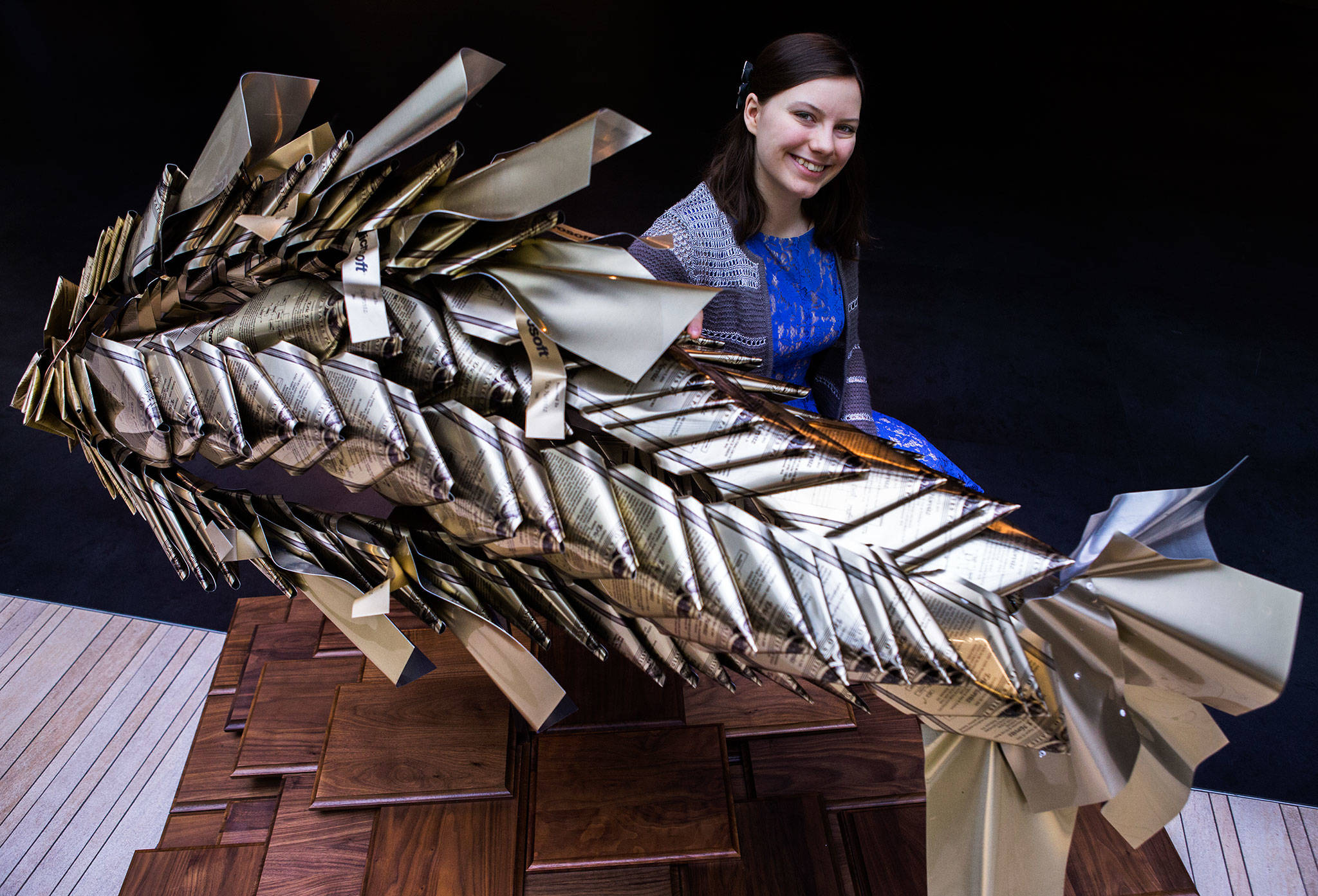EDMONDS — Charlotte Day, 17, is a senior at Edmonds Heights K-12 School and lives in Woodway.
Day spent last summer creating a fish sculpture from upcycled plaques made of wood and aluminum. She named it Patent No. 1. It’s displayed in the Microsoft Research Lab in Redmond.
Question: Can you tell me a little bit about your sculpture?
Answer: Mary Horvitz, Eric Horvitz’s wife, gave me all these patent plaques and asked me to make a sculpture out of them as a surprise for Eric’s birthday.
The entire process of making it probably took all summer, but actually building it and putting it together was probably a month and a half of constant working.
(Eric Horvitz is the director of Microsoft Research Labs and has patented hundreds of ideas for the company. He specializes in artificial intelligence. He’s been a friend of Charlotte’s family for years.)
Q: How many patents are there?
A: They gave us around 350, I think. They didn’t give us all of them because they couldn’t find them all in their house. There are only 275 in the sculpture, because it couldn’t hold any more.
Q: What other materials did you use?
A: Metal rods for the stand, then for the internal structure we used metal bars that we bent in different ways to make the fish. Then, of course, adhesives and wheels on the bottom.
Q: Did you have any help?
A: I could not have done this without everybody who helped. I had friends who helped, my siblings helped, my parents helped. I met an artist from the Rhode Island School of Design (named Laura Jamarillo). She helped me think about the material in different ways.
Q: How did you come up with the plan?
A: I was looking at the plaques and the layering of the metal, because there’s two sheets of metal on each plaque. It reminded me of scales and the idea of fish popped into my head.
… I didn’t come up with all of it on my own. My original plan was to keep the metal flat and cut it into curves, but it didn’t feel like it was going anywhere. Then I was introduced to (Laura) and she does 3-D art.
She picks up a piece of metal, and just starts bending it. I’m like, “You can do that? What? What is this?” It sounds weird because all she’s doing is bending it, but it really did open up a whole new way of thinking about the material. That kind of changed the course of the sculpture.
Q: What do the patents look like?
A: It has the title of the patent and a little diagram or picture, and then a description.
Q: Did you have a favorite?
A: There was one, it had a picture of a bird and I couldn’t take it apart. It’s in my house. It was just too good.
The bird was a parrot, for a voice recognition assistant. He was this parrot you could talk to. I don’t think he could do anything that advanced because it was a long time ago, but that idea.
Q: This is the first sculpture you’ve made. What mediums do you usually work with?
A: I’m mostly a 2-D artist. I do a bit of watercolor and ink. I love ink. It’s probably my favorite medium. But mostly it’s just graphite, sometimes charcoal.
Q: How long have you gone to Edmonds Heights?
A: Since kindergarten. … You have to take the usual classes, but you can do it at your own pace and it’s a lot more self-driven. You have a lot more control over what you want to learn.
Q: You received history credit for this project. How?
A: If you look at the fish, the (patent) years go from oldest to newest to show that the old discoveries lead way to the new. All the names on there represent the people who helped push the future forward and came up with new, innovative ideas.
Q: You’ve been diagnosed with dyscalculia, which means you have trouble with numbers. What has that been like?
A: Nearly my entire family is great at math. They get the concept, they can do the calculations. They just get it. For a long time I felt really down about that. But I realized if I was great at math, I would probably be doing that instead of art.
… (Being diagnosed) was helpful. Like, wait a second, it’s not in my head. I’m not making it up.
Q: What do you hope to do after graduating high school?
A: My current plan is to take a gap year, and I want to go to Japan. After that I want to go to an art school. I’m looking at the Rhode Island School of Design and the Savannah College of Art and Design. Those are the dream schools.
Stephanie Davey: 425-339-3192; sdavey@heraldnet.com; Twitter: @stephrdavey.
Talk to us
> Give us your news tips.
> Send us a letter to the editor.
> More Herald contact information.

























